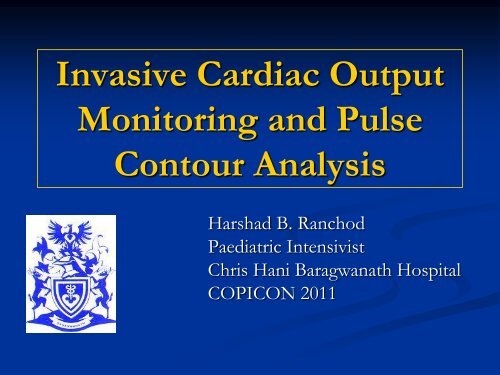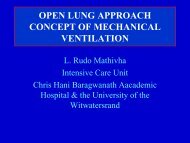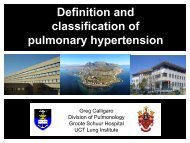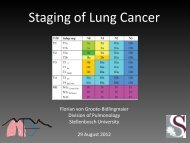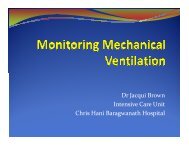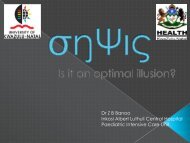Invasive Cardiac Output Monitoring and Pulse Contour Analysis
Invasive Cardiac Output Monitoring and Pulse Contour Analysis
Invasive Cardiac Output Monitoring and Pulse Contour Analysis
Create successful ePaper yourself
Turn your PDF publications into a flip-book with our unique Google optimized e-Paper software.
<strong>Invasive</strong> <strong>Cardiac</strong> <strong>Output</strong><br />
<strong>Monitoring</strong> <strong>and</strong> <strong>Pulse</strong><br />
<strong>Contour</strong> <strong>Analysis</strong><br />
Harshad B. Ranchod<br />
Paediatric Intensivist<br />
Chris Hani Baragwanath Hospital<br />
COPICON 2011
Introduction<br />
• The primary goal of haemodynamic monitoring is to<br />
assess adequacy of systemic perfusion<br />
• The assessment of intravascular volume is one of the<br />
most difficult tasks in clinical medicine.<br />
• The question that confronts most intensive care<br />
providers on a daily basis is:<br />
• will fluid increase perfusion to end organs, or<br />
• will it worsen pulmonary or systemic oedema
Introduction<br />
• This can be especially true when treating septic patients,<br />
where volume expansion is often one of the<br />
cornerstones of early resuscitation.<br />
• SSG 2008<br />
• However, clinical studies have demonstrated that only<br />
about 50% of unstable critically ill patients will actually<br />
respond to a fluid challenge<br />
• Marik PE, Baram M,et al: Chest 2008; 134:172–178<br />
• Michard F, Teboul JL: Chest 2002; 121:2000–2008
Introduction<br />
• Volume overload can have dire consequences<br />
• such as decreased gas exchange <strong>and</strong> increased myocardial<br />
dysfunction.<br />
• Data suggests that a patient’s cumulative fluid balance<br />
affects outcome.<br />
• Wiedemann HP, et al: N Engl J Med 2006; 354:2564–2575<br />
• Vincent JL, et al:. Crit Care Med 2006; 34:344–353<br />
• Br<strong>and</strong>strup B, et al: Ann Surg 2003; 238:641–648<br />
• Rivers EP: N Engl J Med 2006; 354:2598–2600
Assessment of Volume Status<br />
• Physical examination<br />
• Should never be neglected<br />
• There is no substitute for sequential physical<br />
examination to evaluate the effectiveness (or lack<br />
thereof) of our interventions <strong>and</strong> therapeutic<br />
decisions.<br />
• Clinical signs are, however, not as reliable or helpful<br />
in assessing intravascular status.
Assessment of Volume Status<br />
Static measures<br />
• The central venous pressure (CVP) <strong>and</strong> pulmonary artery<br />
occlusion pressure<br />
• poorly predict the haemodynamic response to a fluid<br />
challenge.<br />
• Other techniques for assessing intravascular volume have been<br />
evaluated:<br />
• inferior vena caval diameter<br />
• right ventricular end diastolic volume index<br />
• global end-diastolic volume index (GEDVI), etc.<br />
• However, the experience with these have been uniformly<br />
disappointing !!
Preload Responsiveness<br />
• Preload of the heart<br />
• defined as the wall stress at the end of diastole.<br />
• Volume/ Preload responsiveness<br />
• Predicts if volume administration (eg. for preload<br />
increase) will result in an ↑ cardiac output.
Preload Responsiveness<br />
↑SV<br />
↓SV<br />
• Enomoto TM, et al; Crit Care Clin 26<br />
(2010) 307-321<br />
• If the ventricle is operating<br />
on the steep part of the<br />
curve increasing preload<br />
must induce an increase in<br />
SV (preload responsiveness).<br />
• If the ventricle is operating<br />
on the flat part of the curve<br />
increasing preload will not<br />
induce any significant<br />
increase in stroke volume<br />
(preload unresponsiveness).
Preload Responsiveness<br />
• Fundamentally, the only reason to give a patient<br />
a fluid challenge<br />
• is to ↑stroke volume (SV) <strong>and</strong> ↑cardiac output<br />
(CO).
Preload<br />
• From the example shown, it<br />
is clear that physical<br />
examination <strong>and</strong> static<br />
markers are not an accurate<br />
guide to therapy.<br />
• Hence, this led to the<br />
investigation of dynamic<br />
indices for fluid assessment.<br />
• Enomoto TM, et al; Crit Care Clin 26<br />
(2010) 307-321
Preload Responsiveness<br />
PPV<br />
SVV<br />
• Indices that have been<br />
shown to be predictive<br />
of fluid responsiveness,<br />
include:<br />
• Systolic Pressure Variation<br />
(SPV) <strong>and</strong> the <strong>Pulse</strong> Pressure<br />
Variation (PPV)<br />
• derived from analysis of the<br />
arterial waveform <strong>and</strong><br />
• Stroke Volume Variation<br />
(SVV)<br />
• derived from pulse contour<br />
analysis<br />
(Michard F, Teboul JL: Chest 2002; 121:2000-2008)
Preload<br />
• Enomoto TM, et al; Crit Care Clin 26 (2010) 307-321<br />
• To assess fluid<br />
responsiveness, heart-lung<br />
interactions during<br />
mechanical ventilation have<br />
been used (in a number of<br />
studies)
Haemodynamic Effects of<br />
Mechanical Ventilation<br />
Early Inspiration<br />
↑ Intrathoracic pressure<br />
“squeezing” of pulmonary blood<br />
↑ LV preload<br />
↑ LV stroke volume<br />
↑ systolic arterial blood pressure<br />
Late Inspiration<br />
↑ Intrathoracic pressure<br />
↓ VR to LV <strong>and</strong> RV<br />
↓ LV preload<br />
↓ LV stroke volume<br />
↓ systolic arterial blood pressure<br />
Reuter et al., Anästhesist 2003;52: 1005-1013
↑ Variation = Volume responsiveness<br />
• This ↑ variation in pressures between the inspiratory<br />
phase <strong>and</strong> the expiratory phase<br />
• can be used to identify hypovolaemia <strong>and</strong> volume<br />
responsiveness, <strong>and</strong><br />
• is the basis of indices, including stroke volume variation<br />
(SVV) <strong>and</strong> pulse pressure variation (PPV).
These phasic variations are increased in the<br />
setting of hypovolaemia for several reasons:<br />
1. The underfilled vena cava <strong>and</strong> right atrium<br />
• are more collapsible, <strong>and</strong><br />
• more susceptible to ↑ intrathoracic pressure.<br />
2. Since venous return depends on the venous<br />
pressure gradient<br />
• hypovolaemic patients have ↓ mean circulating<br />
filling pressure more marked ↓ venous return<br />
with positive pressure ventilation.
Reasons for these exaggerated phasic<br />
variations in hypovolaemia :<br />
3. Patients who are functioning on the steep portion of<br />
the Frank-Starling curve<br />
• Larger ↓SV with ↓venous return during each positive<br />
pressure breath.
<strong>Pulse</strong> <strong>Contour</strong> <strong>Analysis</strong><br />
• This method of measuring cardiac output is derived<br />
from variations in the pulse pressure/ arterial pressure<br />
waveform during mechanical ventilation.<br />
• Is based on the principle that SV can be continuously<br />
estimated by analysing the arterial pressure waveform.<br />
• Includes PPV, SVV <strong>and</strong> SPV
Parameters of <strong>Pulse</strong> <strong>Contour</strong> <strong>Analysis</strong> - SVV<br />
The Stroke Volume Variation<br />
• is the variation in stroke volume over the ventilatory cycle.<br />
SV max<br />
SV min<br />
SV mean<br />
SVV =<br />
SV max – SV min<br />
SV mean
SVV<br />
• Difference between the<br />
SV during the inspiratory<br />
<strong>and</strong> expiratory phases of<br />
ventilation, <strong>and</strong><br />
• Requires a means to<br />
directly or indirectly<br />
assess SV
SVV<br />
• SV is calculated on<br />
physiological relationship<br />
between<br />
• SV <strong>and</strong><br />
• area under systolic portion of<br />
the curve.<br />
• PiCCO, LiDCO <strong>and</strong> Flotrac<br />
monitors uses pulse contour<br />
analysis through a proprietary<br />
formula to measure cardiac<br />
output <strong>and</strong> SVV
Parameters of <strong>Pulse</strong> <strong>Contour</strong> <strong>Analysis</strong> - PPV<br />
The <strong>Pulse</strong> Pressure Variation<br />
•is the variation in pulse pressure over the ventilatory cycle.<br />
PP max<br />
PP min<br />
PP mean<br />
PPV =<br />
PP max – PP min<br />
PP mean
<strong>Pulse</strong> Pressure Variation<br />
• Arterial pulse pressure<br />
• is the difference between arterial<br />
systolic <strong>and</strong> diastolic pressure.<br />
• PPV<br />
• Based on the physiological<br />
relationship between <strong>Pulse</strong><br />
Pressure <strong>and</strong> SV
<strong>Pulse</strong> Pressure Variation<br />
• PPV<br />
• Directly proportional to LV Stroke<br />
Volume.<br />
• Inversely related to arterial compliance.<br />
• Assuming that arterial compliance<br />
does not change during a mechanical<br />
breath respiratory changes in<br />
PPV should reflect respiratory<br />
changes in SV.
Use of PPV <strong>and</strong> SVV<br />
• Dynamic indices have repeatedly been shown to be superior to<br />
static measures (for determining preload responsiveness in<br />
critically ill patients).<br />
• In controlled mechanically ventilated adults with sepsis, PPV<br />
threshold value of 13% allowed to discriminate between :<br />
• preload responders to volume (PPV > 13%) from<br />
• Non-responders (PPV
Use of PPV <strong>and</strong> SVV<br />
• PPV/SVV may be helpful to monitor the<br />
haemodynamic effects of volume expansion <br />
normalization of PPV with fluid infusion.<br />
• Lack of improvement of the dynamic markers of<br />
preload after fluid challenge may be viewed as<br />
promoting oedema<br />
(Michard F, Teboul JL: Chest 2002; 121: 2000-2008)<br />
• To date very little data on SVV <strong>and</strong> PPV in critically<br />
ill children<br />
(Proulx F, et al; Pediatr Crit Care Med 2011; 12: 459-466)
Use of PPV <strong>and</strong> SVV<br />
• Recent meta-analysis<br />
• revealed that the diagnostic accuracy of the PPV<br />
(directly measured) was significantly greater (p
Limitations of <strong>Pulse</strong> <strong>Contour</strong><br />
<strong>Analysis</strong><br />
1. Require positive pressure, controlled<br />
ventilation<br />
• Spontaneous Respiratory Efforts (even when<br />
supported by the ventilator) Alter the mechanics<br />
such that these numbers lose their reliability<br />
2. Sinus rhythm is required.<br />
• Arrhythmias or frequent extrasystoles result in<br />
altered SV unreliable PPV interpretation.
Limitations of <strong>Pulse</strong> <strong>Contour</strong><br />
<strong>Analysis</strong><br />
3. Need Higher Tidal Volume (TV > 8ml/kg)<br />
• Most of the early data came from patients ventilated with at<br />
least 8-10 mL/kg tidal volumes.<br />
• In a limited series of various critical illnesses:<br />
• PPV less predictive of volume responsiveness when TV < 8ml/kg<br />
than TV > 8ml/kg<br />
(De Backer D, et al: (2005) Intensive Care Med 31: 517-523)<br />
Preisman S et al. Br J Anaesth. 2005
Limitations of <strong>Pulse</strong> <strong>Contour</strong><br />
<strong>Analysis</strong><br />
4. Requires invasive arterial blood pressure<br />
monitoring with a catheter<br />
• Complications of insertion (bleeding, thrombosis, etc)<br />
• Catheter related infections.<br />
• Prone to the same errors in measurement associated with<br />
invasive blood pressure monitoring :<br />
• Requires accurate calibration<br />
• Air bubbles in the catheter tubing,<br />
• Excessive tubing length,<br />
• Kinks in the tubing,<br />
• Excessively compliant tubing, etc.
Limitations of <strong>Pulse</strong> <strong>Contour</strong><br />
<strong>Analysis</strong><br />
5. A single value never should replace clinical<br />
judgment.<br />
• Eg. A high PPV value in a normotensive patient<br />
with evidence of normal tissue perfusion does not<br />
mean that person requires volume expansion.
Limitations of <strong>Pulse</strong> <strong>Contour</strong><br />
<strong>Analysis</strong><br />
6. Right Ventricular Dysfunction (or acute cor<br />
pulmonale)<br />
• may have marked ↑ RV afterload during<br />
inspiration high PPV observed in cases of<br />
preload unresponsiveness (false positives).
Limitations of <strong>Pulse</strong> <strong>Contour</strong><br />
<strong>Analysis</strong><br />
7. Other extremes of Ventilation MAY affect PPV<br />
7.1 High PEEP<br />
• ↑ intrathoracic <strong>and</strong> transpulmonary pressures ↑ PPV
Limitations of <strong>Pulse</strong> <strong>Contour</strong><br />
<strong>Analysis</strong><br />
7.2 High Respiratory Rate<br />
• Trial with 17 hypovolaemic patients ventilated with<br />
low (14-16 breaths/minute) <strong>and</strong> high (30-40<br />
breaths/minute) respiratory rates<br />
• The authors concluded that respiratory variation in SV<br />
<strong>and</strong> its derivates<br />
• is affected by respiratory rate, <strong>and</strong><br />
• caution against using these indices as predictors of<br />
volume responsiveness at high respiratory rates.<br />
(De Backer D, et al. Anesthesiology 2009;100: 1092–7).
Limitations of <strong>Pulse</strong> <strong>Contour</strong><br />
<strong>Analysis</strong><br />
7.3 Increase in heart rate (HR)<br />
• ↓ PPV from 21% 4%, <strong>and</strong><br />
• ↓ respiratory variation in aortic flow from 23% <br />
6%.<br />
(De Backer D, et al. Anesthesiology 2009;100: 1092–7).
Limitations of <strong>Pulse</strong> <strong>Contour</strong><br />
7.4 HFOV<br />
• “CPAP with wiggle”<br />
<strong>Analysis</strong><br />
• No distinct inspiratory <strong>and</strong> expiratory phases.<br />
• Therefore, only minimal changes in SV would occur<br />
during HFOV low PPV (even in fluid responsive<br />
patients)<br />
(Vincent JL (ed.) Annual Update in Intensive Care <strong>and</strong><br />
Emergency Medicine 2011; pg 322-331)
13%<br />
or PPV
3 Categories of Commercially Available<br />
Haemodynamic <strong>Monitoring</strong> Systems :<br />
1) Calibration-dependent pulse contour analysis devices<br />
• <strong>Pulse</strong> <strong>Contour</strong> <strong>Cardiac</strong> <strong>Output</strong> (PiCCO) <strong>and</strong><br />
• LiDCO<br />
2) Non-calibrated pulse contour analysis devices<br />
• FloTrac system<br />
• Pressure Recording Analytical Method (PRAM)<br />
• LiDCO rapid<br />
3) Alternative techniques<br />
• Doppler ultrasound methods<br />
• <strong>Pulse</strong> dye densitometry<br />
• Bioimpedance cardiography, <strong>and</strong><br />
• Partial CO2 rebreathing (NiCO)
Means of measuring cardiac output<br />
include:<br />
• Pulmonary artery catheter (PAC)<br />
• Transpulmonary thermodilution (TD)<br />
• PiCCO monitor<br />
• Lithium dilution<br />
• LiDCO<br />
• <strong>Pulse</strong> contour analysis<br />
• Calibrated<br />
• (PiCCO, <strong>Pulse</strong>CO system, LiDCO)<br />
• Non-calibrated<br />
• (Flo-trac Vigileo system)
Pulmonary Artery Catheter (PAC)<br />
• Used as a gold st<strong>and</strong>ard therefore all other<br />
methods are compared to this.<br />
• Uses different methods for calculating CO<br />
• Thermodilution has been most commonly<br />
used to measure cardiac output in the adult<br />
population.
Complications of PAC<br />
• Catheter insertion is difficult in<br />
• smaller patients (5-10kg) <strong>and</strong><br />
• those with aberrant cardiopulmonary anatomy<br />
• Line-related complications<br />
• pneumothorax, bleeding or infections<br />
• Arrhythmias<br />
• benign <strong>and</strong> life-threatening ventricular arrhythmias <strong>and</strong> right bundle<br />
branch block<br />
• PA-related complications<br />
• rupture, infarction, thrombi, haemorrhage, vegetations.
Transpulmonary Thermodilution<br />
(TPTD)<br />
• Controversy surrounding PAC’s safety <strong>and</strong><br />
efficacy has prompted development of newer<br />
less invasive techniques.<br />
• The PiCCO monitor is currently the only<br />
commercially available device that uses the<br />
TPTD method to measure cardiac output.
Transpulmonary Thermodilution<br />
(TPTD)<br />
• The transpulmonary thermodilution technique<br />
(TPTD) allows assessment of various indices<br />
• volumetric preload,<br />
• cardiac output, <strong>and</strong><br />
• extravascular lung water.<br />
• without the need to pass a catheter through the<br />
right heart.
TPTD <strong>and</strong> PiCCO<br />
• Need a st<strong>and</strong>ard central venous catheter.<br />
• CVP is usually placed above diaphragm (IJ or SCV)<br />
• Can be performed using a femoral CVP.<br />
<strong>and</strong><br />
• A specialized femoral or axillary arterial<br />
catheter with a thermistor at its tip is also<br />
required.<br />
• 3F or 4F arterial catheter is available for femoral<br />
artery cannulation in children
TPTD <strong>and</strong> PiCCO<br />
• A known volume of thermal indicator (ice-cold saline) is injected<br />
via a central venous catheter.<br />
• Depends on body weight (varies from 2mls – 20mls)<br />
• The resulting packet of cooler blood traverses the thorax <strong>and</strong> <br />
is sensed by a thermistor in the femoral or axillary position <br />
generating a TD dissipation curve.<br />
• <strong>Cardiac</strong> output is then calculated from the curve using the<br />
modified Stewart-Hamilton equation for TD.<br />
• The average result from three consecutive bolus injections is<br />
recorded.
TPTD <strong>and</strong> PiCCO<br />
• Manual calibrations are necessary:<br />
• To compensate for inter-individual differences in<br />
compliance <strong>and</strong> resistance of the arterial vessel<br />
system.<br />
• Frequent recalibration is necessary during<br />
• rapidly changing clinical conditions,<br />
• haemorrhage,<br />
• shock <strong>and</strong><br />
• vasodilation<br />
(Gazit AZ, et al; Ped Crit Care Med 2011;12[Suppl.]:S55–S61)
PiCCO<br />
• PiCCO method may give incorrect thermodilution<br />
measurements in patients with<br />
• intracardiac shunts,<br />
• aortic aneurysm,<br />
• aortic stenosis,<br />
• pneumonectomy,<br />
• macro lung embolism, <strong>and</strong><br />
• extracorporeal circulation (if blood is either extracted from<br />
or infused back into the cardiopulmonary circulation).<br />
(Gazit AZ, et al; Ped Crit Care Med 2011;12[Suppl.]:S55–S61)
PiCCO<br />
• It is therefore of limited use in<br />
• the peri-operative care of children with complex congenital<br />
heart defects.<br />
• May be useful<br />
• in children with normal cardiac anatomy who present with<br />
cardiogenic shock, or<br />
• in the postoperative care of children after heart<br />
transplantation or biventricular repair<br />
(Gazit AZ, et al; Ped Crit Care Med 2011;12[Suppl.]:S55–S61)
PiCCO<br />
• Use of this monitor in children is overall simple <strong>and</strong> requires<br />
minimal training.<br />
• In haemodynamically unstable patients,<br />
• it requires frequent recalibrations to obtain reasonable accuracy.<br />
• Both the PiCCO-measured dynamic <strong>and</strong> static variables were<br />
shown to have good correlation with CI <strong>and</strong> fluid<br />
responsiveness.<br />
Gazit AZ, et al; Ped Crit Care Med 2011;12[Suppl.]:S55–S61<br />
Wong HR, et al; (Pediatr Crit Care Med 2011; 12[Suppl.]:S66 –S68
Lithium Dilution / LiDCO<br />
• Instead of using cold injectate indicator dilution,<br />
methods using intravenous lithium have been<br />
developed to determine CO (LiDCO).<br />
• Lithium can be injected via central or peripheral<br />
venous catheters<br />
• Is detected in a st<strong>and</strong>ard radial arterial line<br />
• Negates the need to place a catheter across heart valves<br />
(PAC) or to place a femoral or axillary arterial catheter<br />
(TPTD).<br />
• A dye dissipation curve is generated
LiDCO<br />
• The use of this system is problematic due to the<br />
complexity of its calibration.<br />
• The available data support its use in patients with<br />
hyperdynamic circulation.<br />
• However, its validity in patients with low CO has not<br />
been studied.<br />
• Overall, it appears that more data is required before use<br />
of this system in critically ill children<br />
(Gazit AZ, et al; Ped Crit Care Med 2011;12[Suppl.]:S55–S61)
FloTrac Vigileo System<br />
• Comprised of the FloTrac sensor <strong>and</strong> a processing<br />
display unit (Vigileo).<br />
• Attempts to determine CO by pulse contour analysis<br />
without employing a second technique for calibration.<br />
• Calibration allows a way to account for changes in<br />
vascular compliance, which cannot be easily measured<br />
clinically.
FloTrac Vigileo System<br />
• The makers of the Flo-Trac device claim to have<br />
solved this calibration problem using<br />
• continuous self-calibration through an automatic<br />
vascular tone adjustment involving complex<br />
algorithms based on<br />
• mean arterial pressure,<br />
• age,<br />
• height,<br />
• weight, <strong>and</strong><br />
• gender of patients.
FloTrac Vigileo<br />
• The FloTrac system, comprised of the Flotrac sensor<br />
<strong>and</strong> a processing display unit (Vigileo).<br />
• Attempts to determine CO by pulse contour analysis<br />
without employing a second technique for calibration.<br />
• Calibration allows a way to account for changes in<br />
vascular compliance, which cannot be easily measured<br />
clinically.
What else can these monitors do<br />
DO2 = CaO2 X <strong>Cardiac</strong> <strong>Output</strong><br />
CO = HR x STROKE VOLUME (SV)<br />
PRELOAD CONTRACTILITY AFTERLOAD<br />
PPV/ SVV/ GEDVI GEF/CFI/dPmx SVRI
Contractility<br />
• Contractility is a measure of the performance of the<br />
heart muscle<br />
• Is a further important determinant of cardiac output.<br />
• Some Contractility parameters include:<br />
• CFI (<strong>Cardiac</strong> Function Index)<br />
• GEF (Global Ejection Fraction)<br />
• dPmx (maximum rate of the increase in pressure)
Afterload - SVRI<br />
• Systemic Vascular Resistance (SVR)<br />
• Important determinant of afterload.<br />
• Is the resistance the blood encounters as it flows through the<br />
vascular system.<br />
• SVR index (SVRI) – SVR indexed to BSA.<br />
• Normal = 1200-2400 dyn.s.cm-5.m2<br />
• SVRI – helps to guide catecholamine <strong>and</strong> volume<br />
therapies.<br />
• Eg. High SVR Vasoconstriction consider :<br />
• Decreasing vasopressors or adding vasodilator
Extravascular Lung Water (EVLW)<br />
• Reflects the amount of fluid in the interstitium <strong>and</strong> in<br />
the alveolar space.<br />
• Accepted normal value = < 8ml/kg<br />
• Paeds : may be up to 20 ml/kg.<br />
• EVLW > 10ml/kg pulmonary oedema (adults)<br />
• Is useful for differentiating <strong>and</strong> quantifying lung<br />
oedema
EVLW<br />
• May have prognostic value<br />
• Reports that in adult patients, mortality increases with<br />
increasing volumes of EVLW<br />
• Sakka SG, et al: (2002) Chest 122:2080-2086<br />
• Berkowitz DM, et al: (2008) Crit Care Med 36:1803-1809<br />
• EVLWi decreased significantly in survivors already at<br />
24 hours <strong>and</strong> remained constant thereafter<br />
• Sustained EVLW > 10ml/kg worse survival.<br />
• Lubrano R, et al: Intensive Care Med (2011) 37:124-131
Conclusion<br />
• The quest for the holy grail of non-invasive cardiac output<br />
assessment continues.<br />
• NO IDEAL MONITOR<br />
• Tailor choice of monitor by matching your requirements to information<br />
offered by monitor<br />
• Dynamic measures proving to be more useful modality<br />
• Our job is to learn what variables to measure, to measure them<br />
correctly, to institute effective therapies where available, <strong>and</strong> to<br />
do this with minimum patient risk.
Conclusion<br />
• We need to integrate all the interrelated information at<br />
the bedside <strong>and</strong> try to decide on the best course of<br />
management, based on the best available scientific<br />
information.<br />
• Know the limitations of your monitor.<br />
• Assess data in conjunction with clinical picture.<br />
MONITOR DATA IS ONLY AS GOOD AS THE<br />
PERSON INTERPRETING IT !!
Conclusion<br />
• We need to integrate all the interrelated information at<br />
the bedside <strong>and</strong> try to decide on the best course of<br />
management, based on the best available scientific<br />
information.<br />
• Know the limitations of your monitor<br />
• Assess data in conjunction with clinical picture<br />
MONITOR DATA IS ONLY AS GOOD AS THE<br />
PERSON INTERPRETING IT !!
Thank you.


